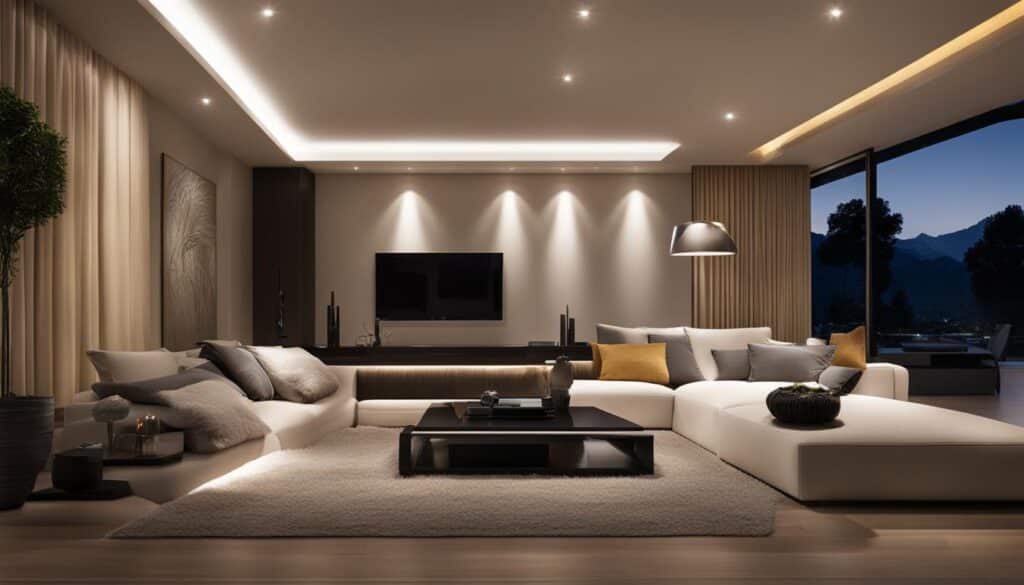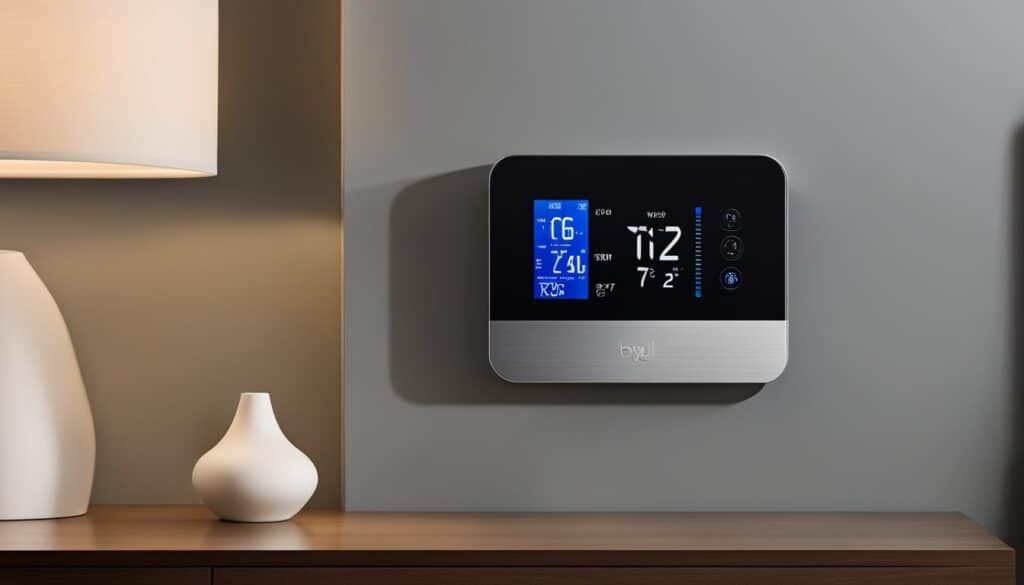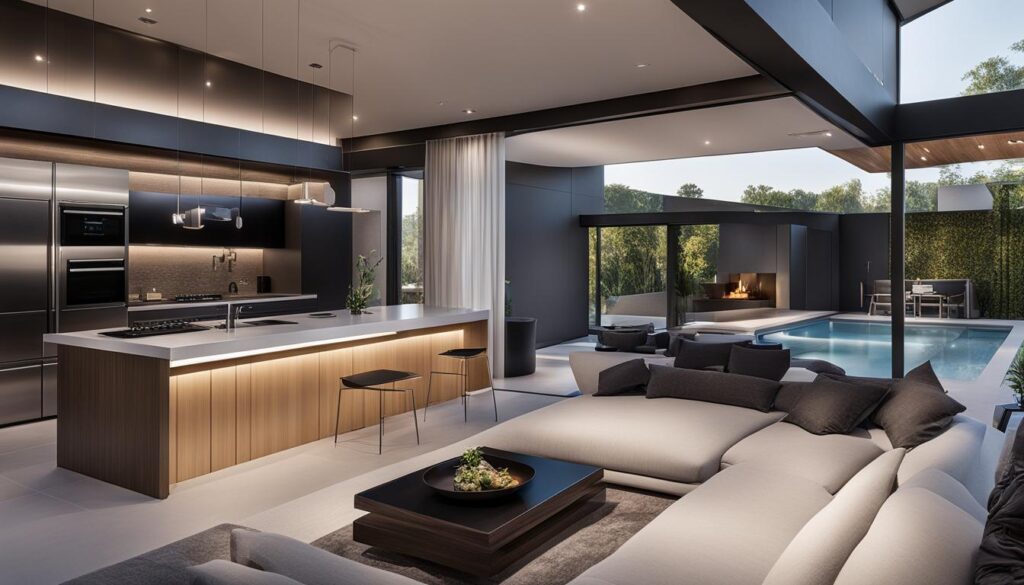Building a smart home may seem like a daunting task, but with the right guidance and tips, you can create a connected living experience that offers convenience, security, and energy efficiency. By focusing on smart home automation, integrating home automation systems, and carefully selecting smart home devices, you can transform your house into a smart home that simplifies your life.
Smart home automation is the foundation for creating a connected living space. It involves using technology to automate and control various aspects of your home, such as lighting, temperature, security, and entertainment. By implementing home automation systems, you can centralize control and management, making it easier to monitor and adjust your home environment according to your preferences.
When it comes to selecting smart home devices, it’s essential to consider your specific needs and priorities. Smart lighting systems, smart thermostats, home security cameras, and multi-room audio systems are just a few examples of the devices that can enhance your smart home experience. By carefully choosing these devices, you can customize and optimize your home to suit your lifestyle.
Building a smart home is not a one-size-fits-all approach. Each home has its unique requirements and challenges. Therefore, it’s crucial to plan and research before embarking on your smart home journey. By understanding the basic principles of smart home technology and considering the integration, security, connectivity, energy efficiency, and installation aspects, you can build a smart home that meets your needs and preferences.
Table of Contents
Key Takeaways:
- Smart home automation is the foundation for creating a connected living experience.
- Integrating home automation systems centralizes control and simplifies management.
- Choose smart home devices that align with your specific needs and priorities.
- Plan and research before embarking on your smart home journey.
- Consider integration, security, connectivity, energy efficiency, and installation when building a smart home.
Choosing the Right Smart Lighting
Smart lighting is an essential component when building a smart home. It serves as the entry point into the world of home automation and offers a wide range of possibilities to enhance your living space. By incorporating smart lighting systems, such as smart bulbs, switches, plugs, and speakers, you can transform the way you interact with and control your home lighting.
Smart Bulbs: Smart bulbs are a popular choice for introducing smart lighting into your home. These bulbs communicate over Wi-Fi or Bluetooth, allowing you to control them remotely through a smartphone app or a virtual assistant. With the ability to adjust brightness, color temperature, and even create schedules, smart bulbs offer customizable lighting experiences tailored to your preferences.
Smart Switches: Smart switches and dimmers provide an alternative solution to smart lighting. These devices replace traditional light switches and enable smart control over your existing lighting fixtures. With smart switches, you can turn lights on and off, dim them, and even set up automation routines for hands-free lighting control.
Smart Plugs: If you have lamps or other non-smart lighting fixtures, smart plugs are a convenient option. These plugs can be easily inserted into any electrical outlet, transforming ordinary appliances into smart devices. By connecting your lamps or other lighting fixtures to a smart plug, you can control them remotely or integrate them into automation routines.
Smart Speakers: Integrating your smart lighting with smart speakers adds a new level of convenience to your home. With voice control capabilities, you can simply ask your smart speaker to turn the lights on or off, adjust brightness, or even change colors. This hands-free approach allows for seamless control and enhances the overall user experience.

“By incorporating smart lighting into your home, you can create personalized lighting scenes, save energy, and experience the convenience of voice control – all contributing to a smarter and more enjoyable living environment.”
Exploring Smart Thermostats for Comfort and Energy Efficiency
Smart thermostats are revolutionizing the way we control the heating, ventilation, and air conditioning (HVAC) systems in our homes. These intelligent devices offer both comfort and energy savings, making them an essential component of any smart home.
With smart thermostats, you no longer have to manually adjust the temperature throughout the day. These devices can detect occupancy and adjust the HVAC system accordingly, optimizing energy usage and enhancing comfort. Whether you’re at home or away, you can rely on your smart thermostat to maintain the perfect temperature.
But smart thermostats go beyond just basic temperature control. Many models come with remote room sensors that allow for personalized temperature control in different areas of your house. This means that each room can be set to the ideal temperature, taking into account factors like sunlight exposure or individual preferences. It’s a level of customization that ensures everyone in your household stays comfortable.
One of the key advantages of smart thermostats is their ability to deliver significant energy savings. By optimizing heating and cooling based on occupancy and specific settings, these devices can reduce energy waste and lower your utility bills. In fact, studies have shown that smart thermostats can result in energy savings of up to 15% or more.
| Benefits of Smart Thermostats |
|---|
| 1. Energy Savings |
| 2. Enhanced Comfort |
| 3. Customized Room Control |
| 4. Remote Accessibility |
| 5. Integration with Smart Home Systems |
With the ability to connect to your Wi-Fi network, smart thermostats also offer remote accessibility. This means that whether you’re at work, on vacation, or simply in a different part of your home, you can control your thermostat using a companion app on your smartphone. Forgot to adjust the temperature before leaving the house? Not a problem. Simply open the app and make the necessary changes.
Furthermore, smart thermostats can integrate seamlessly with other smart home systems, allowing for enhanced automation and convenience. You can create schedules and routines that align with your lifestyle, such as automatically lowering the temperature when you go to bed or raising it before you wake up.

Smart thermostats are compatible with most HVAC systems, making them a versatile choice for any home. Whether you have a central heating and cooling system, heat pumps, or even electric baseboard heaters, there’s a smart thermostat that can meet your needs.
By integrating a smart thermostat into your smart home, you can achieve unparalleled comfort, enjoy significant energy savings, and improve the overall efficiency of your HVAC system. It’s a smart investment that pays off both in terms of convenience and sustainability.
Enhancing Home Security with Smart Cameras and Door Locks
Home security is a critical aspect of a smart home. By incorporating advanced technologies such as home security cameras, smart door locks, video doorbells, and motion-sensor cameras, you can significantly enhance the safety and protection of your living space.
Smart cameras, both indoor and outdoor, provide 24/7 monitoring and surveillance capabilities. With live streams and recorded footage accessible from your smartphone or computer, you can keep a watchful eye on your home at all times. Whether you want to check in on your pets, monitor package deliveries, or deter potential intruders, home security cameras offer peace of mind and increased situational awareness.
Video doorbells have emerged as an essential component of a smart home security system. These devices allow you to remotely interact with visitors at your front door, enhancing convenience and security. With two-way audio and HD video, you can communicate with delivery personnel, instruct service providers, or simply keep an eye on your doorstep. Video doorbells also act as a deterrent, discouraging potential intruders from approaching your property.
Smart door locks offer an added layer of convenience and security by eliminating the need for physical keys. With remote access control through your smartphone, you can lock and unlock your doors from anywhere. Whether you’re welcoming guests while away from home or granting temporary access to service providers, smart door locks make the process effortless and secure. Additionally, some models offer advanced features such as auto-locking, tamper alerts, and integration with other smart home devices.
Motion-sensor cameras are another valuable addition to your smart home security setup. These devices are designed to detect and capture any suspicious activity around your property. Whether placed indoors or outdoors, motion-sensor cameras can snap images or record video whenever motion is detected, alerting you to potential threats. With intelligent motion detection algorithms and adjustable sensitivity settings, you can customize the monitoring experience to suit your specific needs.
By integrating home security cameras, video doorbells, smart door locks, and motion-sensor cameras, you can create a comprehensive and robust smart home security system. These devices form a network of protection, allowing you to monitor and safeguard your property with ease and confidence.
Creating a Smart Audio System for Multi-Room Music Streaming
A smart audio system can revolutionize your home entertainment experience, allowing you to enjoy high-quality music streaming throughout multiple rooms. Whether you’re hosting a party or simply relaxing at home, a multi-room speaker system, smart speakers, or soundbars with built-in voice assistants can provide the perfect soundtrack for any occasion.
One option for creating a multi-room audio setup is to invest in a multi-room speaker system. These systems typically consist of multiple wireless speakers that can be placed in different rooms, all connected to a central hub or network. With this setup, you can synchronize music playback, streaming the same song in every room for a cohesive listening experience. Alternatively, you can choose individual tracks for each room, tailoring the music to suit the preferences of each occupant.
If you prefer a more streamlined approach, smart speakers are a great choice. Smart speakers like the popular Amazon Echo or Google Nest devices combine high-quality audio with built-in voice assistants, such as Alexa or Google Assistant. These speakers enable seamless music streaming and offer a wide range of additional features, from controlling other smart home devices to answering questions and providing real-time information.
For those seeking a more immersive audio experience, soundbars with built-in voice assistants are an excellent option. These sleek and compact devices not only provide enhanced sound quality for your TV but also offer music streaming capabilities. With a soundbar, you can enjoy a home theater-like experience, immersing yourself in your favorite movies, television shows, and music.
Furthermore, smart speakers with displays can serve as central interaction points for controlling other smart home devices. These devices offer a visual interface that allows you to adjust settings, manage playlists, and even display video feeds from home security cameras. With a quick glance, you can easily stay connected and in control of your smart home ecosystem.
When building your smart audio system, take into consideration factors such as sound quality, compatibility with your existing devices, and integration with your preferred music streaming platforms. By carefully selecting the right multi-room speaker system, smart speakers, soundbars, or a combination of these devices, you can create a truly immersive and seamlessly connected audio experience throughout your home.
Benefits of a Smart Audio System:
- Seamless music streaming across multiple rooms
- Customizable music playback for each room
- Voice control for easy command and convenience
- Integration with other smart home devices
- Enhanced sound quality and immersive experience
- Central control and display options
Investing in a smart audio system not only enhances your home entertainment but also elevates your overall smart home experience. With synchronized music streaming, customizable playback options, and convenient voice control, you can enjoy a seamless audio experience across your entire living space.
Comparison of Multi-Room Speaker Systems, Smart Speakers, and Soundbars
| Feature | Multi-Room Speaker Systems | Smart Speakers | Soundbars with Voice Assistants |
|---|---|---|---|
| Wireless connectivity | Yes | Yes | Yes |
| Built-in voice assistant | No | Yes | Yes |
| Streaming platforms | Varies | Varies | Varies |
| Customizable playback | Yes | Yes | No |
| Integration with smart home devices | Varies | Yes | Varies |
| Sound quality | Varies | Varies | High |
| Visual display | No | Yes | No |
Integrating Smart Smoke and Carbon Monoxide Detectors
Smart smoke detectors and carbon monoxide detectors are essential components of a comprehensive home safety system. These advanced devices offer enhanced features and capabilities beyond traditional detectors, providing an extra layer of protection for you and your loved ones.
By integrating smart smoke and carbon monoxide detectors into your smart home, you can enjoy the following benefits:
- Instant alerts: Smart detectors can send immediate notifications to your smartphone and other authorized contacts in the event of a fire or carbon monoxide leak. This allows for prompt action and potentially lifesaving measures.
- Remote monitoring and control: With smart detectors, you can monitor your home’s safety status even when you’re away. Through a dedicated app, you can check the status of the detectors, receive real-time updates, and remotely control their settings.
- Seamless integration with other smart devices: Smart smoke and carbon monoxide detectors can be interconnected with other smart home devices, such as smart thermostats and security systems. This integration allows for coordinated responses, such as automatically turning off HVAC systems to prevent the circulation of smoke or toxic gases in case of an emergency.
- Emergency lights for guidance: Some smart smoke detectors come equipped with built-in emergency lights. These lights can guide you through smoke-filled environments, increasing your chances of safely evacuating your home.
When choosing smart smoke detectors and carbon monoxide detectors, it’s essential to consider factors such as reliability, compatibility with your smart home ecosystem, and compliance with safety regulations. Opt for trusted brands that have a proven track record in providing reliable and accurate detection.
Protecting your home and ensuring the safety of your loved ones should be a top priority. By integrating smart smoke and carbon monoxide detectors into your smart home, you can have peace of mind knowing that you have advanced safety features and immediate alerts in case of emergencies.
| Key Features | Benefits |
|---|---|
| Instant alerts | Receive immediate notifications on your smartphone and take prompt action in case of emergencies. |
| Remote monitoring and control | Monitor the safety status of your home and control your detectors remotely through a dedicated app. |
| Integration with other smart devices | Interconnect with your smart home ecosystem for coordinated responses and enhanced safety. |
| Emergency lights | Guidance through smoke-filled environments with built-in emergency lights. |
Conclusion
Building a smart home is an exciting venture that requires careful planning and consideration. By incorporating smart home technology, integrating various devices, prioritizing security, ensuring connectivity, optimizing energy efficiency, and paying attention to installation, you can create a truly connected living experience.
When starting your smart home journey, begin with smart lighting. Explore different options such as smart bulbs, switches, and plugs, and consider integrating them with smart speakers for convenient control.
To enhance comfort and energy efficiency, invest in a smart thermostat that can adapt to your preferences and save energy by optimizing temperature settings. This will integrate seamlessly with your HVAC system and bring significant savings over time.
Home security is paramount, and integrating smart cameras, door locks, and motion-sensor cameras can provide peace of mind and deter potential intruders. Additionally, consider creating a smart audio system for multi-room music streaming, using either multi-room speaker systems, smart speakers, or soundbars with built-in voice assistants.
Finally, don’t forget to prioritize safety by integrating smart smoke and carbon monoxide detectors. These devices can send alerts and ensure a prompt response during emergencies.
By following these essential tips and being mindful of compatibility during installation, you can build a smart home that encompasses seamless automation, enhanced security, energy efficiency, and a connected living experience for you and your family.
FAQ
Are smart home devices compatible with each other?
Smart home devices from different brands can sometimes be compatible with each other if they follow industry-standard protocols like Zigbee or Z-Wave. However, it’s essential to check for compatibility before purchasing any smart home device to ensure seamless integration.
Do I need professional installation for smart home devices?
While some smart home devices can be easily installed by homeowners, others may require professional installation, especially for complex systems like security cameras or integrated home automation systems. It’s important to consult the manufacturer’s instructions or seek professional help if needed.
Can I control my smart home devices remotely?
Yes, most smart home devices offer remote access through smartphone apps or cloud-based platforms. This allows you to control and monitor your devices from anywhere, providing convenience and peace of mind.
How can I ensure the security of my smart home devices?
To ensure the security of your smart home devices, it’s important to take measures like using strong and unique passwords, keeping your devices’ software updated, and regularly monitoring for any suspicious activity. Additionally, choosing devices with built-in security features and using a secure Wi-Fi network can also enhance the security of your smart home.
Can smart home devices help me save energy?
Yes, smart home devices like smart thermostats can optimize energy usage by adjusting heating and cooling based on occupancy patterns. Smart plugs and switches can also help save energy by allowing you to control and schedule the operation of appliances and lights.
How can I expand my smart home system in the future?
To expand your smart home system in the future, it’s important to choose devices that are compatible with each other and can be easily integrated into your existing setup. Additionally, considering devices that are part of larger ecosystems, like Amazon Alexa or Google Assistant, can provide flexibility and compatibility with a wide range of smart home devices.
Can smart home devices be controlled using voice commands?
Yes, many smart home devices, especially those with built-in voice assistants like Amazon Alexa or Google Assistant, can be controlled using voice commands. This offers a convenient and hands-free way to interact with your smart home devices.


